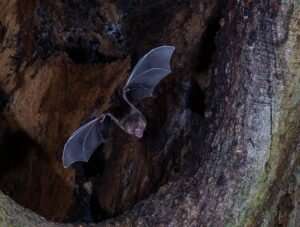A common vampire bat (Desmodus rotundus) in Lamani, Belize, exiting its tree roost to search for its breakfast of mammalian blood. Credit: Sean Werle
The sense of smell is one of the most poorly understood of the five major senses. But now an international team of scientists led by Laurel Yohe of Stony Brook University suggests a new method to quantify olfactory receptors by sequencing them in vampire bats may hold the key to unraveling the mysteries of smell. Their findings are published this week in Molecular Ecology Resources.
According to Yohe, a Ph.D. alumna and affiliated research associate in the lab of Liliana Dávalos in the Department of Ecology and Evolution, as well as a National Science Foundation Postdoctoral Fellow at Yale University, understanding how to obtain accurate numbers of olfactory receptor counts in the mammalian genome is major aspect to understanding the sense of smell. The difficulty is that genes related to smell are highly similar to one another, and therefore determining the correct sequencing of the hundreds of olfactory receptors is difficult and similar to analyzing many pieces of a puzzle that are nearly the same.
The researchers selected the vampire bat to compare for the first time different ways to sequence olfactory receptors. The vampire bat relies on its sense of smell to find its prey and has a comparable number of olfactory receptors to humans (approximately 400). They compared different methods to get the DNA sequences of olfactory receptor genes using the vampire bat genome. The methods ranged from traditional polymerase chain reaction (PCR) and cloning to newer technologies to probe sequences of bat olfactory receptors.
They discovered that an approach called "targeted sequence capture," which involves the researchers to design generic "search" motifs that "bait" olfactory receptors. This makes for a quick and efficient sequencing of the olfactory receptors. By using this method, they discovered a fast and cost-effective method to find up to 90 percent of the genes involved in smell. The method also found almost four times the amount of intact olfactory receptors as was previously reported in published works.
"The comparison study changes our interpretation of what constitutes a good smeller," says Yohe. "Our method makes it feasible to probe the DNA behind the sense of smell, across hundreds of species and thousands of genes, which may ultimately illuminate some of the mysteries behind the sense of smell."
More information: Laurel R. Yohe et al. Evaluating the performance of targeted sequence capture, RNA-Seq, and degenerate-primer PCR cloning for sequencing the largest mammalian multigene family, Molecular Ecology Resources (2019). DOI: 10.1111/1755-0998.13093
Journal information: Molecular Ecology Resources
Provided by Stony Brook University























